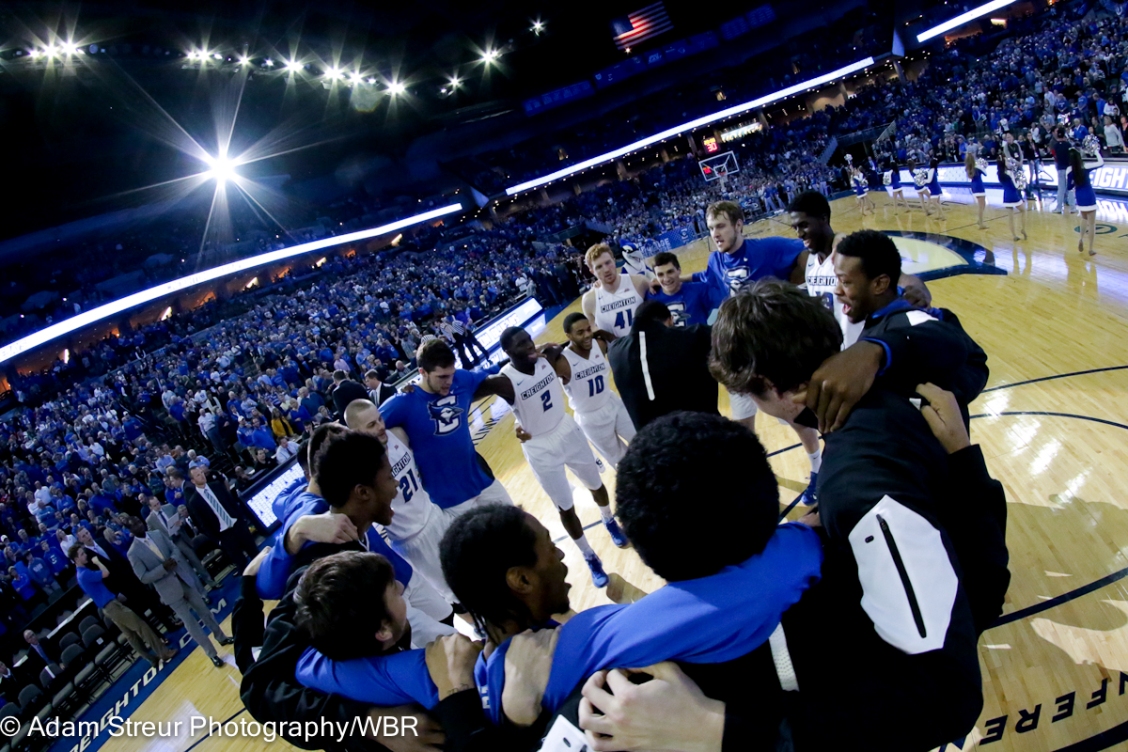[dropcap]BracketBusters[/dropcap] began in 2002 as a made-for-TV event created by ESPN, with the idea of helping top mid-majors get marquee games (and TV exposure) during the season’s final month by pitting them against one another. In it’s initial form, it was a great idea executed well. Called “Bracket Buster Saturday”, it featured nine games, all televised on one ESPN network or another, all played on the same day giving top mid-major programs saturation coverage just as casual fans began paying attention to college hoops.
Prior to that first year, top mid-major leagues like the MVC, CAA, MAC, WAC, WCC, and Horizon worked with ESPN to pick 18 teams they figured would be in contention for at-large berths to the Big Dance. Those teams set aside a date on their schedules in late February, with half designated as “home” teams and half as “road” teams, and then in early February ESPN created matchups based on how those 18 teams had fared during the season.
That streamlined version of the event was fantastic in theory, but was problematic in practice. Gonzaga, Butler, and the entirety of the Atlantic-10 and Mountain West either dropped out after the first couple of years, or flat-out refused to participate at all. And the 18 teams picked before the season weren’t always the best 18 by the time February rolled around. The first problem wasn’t easily rectified, but the second was, and by 2006 the event had ballooned to over 100 teams. ESPN basically threw everyone from participating leagues into the event to guard against surprises, solving one problem while creating another.
The expanded pool of teams to pick from was great for teams like the 2007-08 Drake Bulldogs, who certainly wouldn’t have been in a group of 18 teams expected to contend during the preseason, but were ranked in the Top 25 by February. And it was great for the Bluejays in years like 2012, when Creighton drew a good Long Beach State team that was squarely on the NCAA bubble but wasn’t necessarily predicted to be there in August.
It was terrible for teams going through a down year, as it saddled them with an often uninteresting game smack in the middle of conference play, sometimes halfway across the country. Creighton experienced that in 2010 and 2011, when they played Loyola-Chicago and at Akron, two games that were met with a “meh” by fans, players, and coaches alike. When that initial Loyola matchup was announced in 2010, we called BracketBusters “relatively useless”, and in 2011 prior to the Akron game, I wrote this:
“Its fashionable to hate on BracketBusters. Ask ten fans of a mid-major school for their opinion on it, and you’re likely to get at least eight of them to express their displeasure with the event for one reason or another. Some think it comes at a bad time, in the home stretch of the conference season when teams would rather be focused on the fight for MVC supremacy. Some think it has entirely too many teams — 114, or nearly 1/3 of Division 1. Some think its a no-win situation, that a win has rarely helped push a bubble team from the MVC into the Big Dance, but a loss has certainly kept teams out. Some think its outlived its usefulness now that one-time participants such as Butler have pulled out. A pretty small minority actually like the event, but with MVC Commissioner Doug Elgin being one of them, its not likely to go anywhere, now matter how vocal the league’s coaches come out against it.
And so it is what it is. If your team gets one of the eleven TV games, it gives you a nice non-conference game on a busy Saturday of hoops that may or may not actually do any good when it comes to procuring an at-large bid — and provided the matchup isn’t against a one-hit wonder, it gives you a nice return game in a future season, too. If you’re in the pool of 92 other teams who aren’t in one of the TV games, it gives you a non-conference game against a team of similar achievement — Evansville, a middle of the pack MVC team, drew Murray State, a middle of the pack OVC team; Bradley, a terrible MVC team, drew a team with an RPI of 303 in Tennessee-Martin. Fans of teams on TV are usually excited by the challenge; fans of the teams who aren’t generally complain about the event. There’s far more of the latter than the former, which is part of why it seems like everyone hates BracketBusters.”
Even in years that wound up with NCAA berths, it wasn’t always great; in 2005 Creighton hosted UT-Chattanooga (an untelevised game they won 100-68) and went on to the NCAA’s after winning the MVC Tournament, but the next year they lost the return game to a much worse Chattanooga team, which was used against them by the committee when March rolled around.
That’s right — the dreaded return game. BracketBusters wasn’t a one-off game. Teams were locked into a home-and-home, so what was a great game one year might be a drag the next, or worse, if you got a lower-tier opponent the first time around, you were stuck with them for two straight years. Unless, that is, you pushed the return game off.
Creighton played Loyola-Chicago in the BracketBusters event all the way back in 2010, during Dana Altman’s final year on the Hilltop. They’ve delayed the return game every year since, making it one of the longest running jokes/mysteries surrounding the non-conference schedule every year. Every summer, the question is asked, ‘Will this be the year they finally return the game to Loyola?’
In 2015, in Greg McDermott’s sixth season in Omaha, they finally close the book on BracketBusters by returning that game. It ends the last tangible, contractual tie they have to mid-major life, and while that’s cause for celebration on one hand, it conjures up some a lot of emotion on the other. It’s been an event with both highlights and lowlights for Creighton, after all, so with this being THE END, let’s take a stroll down memory lane for old times’ sake, shall we?
February 22, 2003 | vs Fresno State
The first of two times the Jays were matched up with Fresno State in BracketBusters (leading to four games), the 2003 game had the distinction of being the first-ever BracketBuster game in history owing to it’s 11:00am tip time. Creighton won 67-66 thanks to seven 3-pointers and 27 points from Kyle Korver, in front of a national TV audience on ESPN2 (a bit of a rarity in those days). They returned the game the following December, winning 70-62 in overtime after Nate Funk hit a three-pointer at the buzzer to force the extra period.
February 21, 2004 | at Kent State
In its’ second year, Creighton was a designated “road” team, and was matched up with the Golden Flashes of Kent State. Another featured game on ESPN2, the game is best remembered (or forgotten, perhaps?) for a 19-0 Kent State run turning a 42-41 Creighton lead with 14:30 to play in the game into a 60-42 score with 7:48 to go. The Jays lost 70-55, damaging an already shaky NCAA Tournament resume.
Adding insult to injury, they lost the return game in Omaha a year later, too, 67-58 after another big second half Kent State run. The two teams have not met since, and that’s quite alright.
February 19, 2005 | vs UT-Chattanooga
In Year Three, Creighton entered BracketBusters with a pedestrian 16-10 record and no realistic at-large hopes, and as such were matched up with the UT-Chattanooga Mocs. In their first un-televised BracketBuster game, the Jays had a historic offensive day, setting a school and conference record for most three-pointers made in a game with 20. This was the record they broke with their 21-made three-pointers at Villanova in 2014, incidentally. The 100-68 win was also the game often cited as the turning point in the career of future All-MVC and NBA player Anthony Tolliver because of the talk Dana Altman had with him after he was the only player to not score in the win, fouling out in just nine minutes of action.
The next year, Creighton lost 69-64 in the return game to a Mocs team that was 1-5 entering the game. It was the first game following Nate Funk’s shoulder injury at DePaul, and the shorthanded Jays would come to regret that loss when they had a late-season surge.
February 18, 2006 | vs Fresno State
The fourth year of BracketBusters saw a return of Fresno State to Omaha, and the first late-night game at the CLink. Tipping off at 11:02pm after the late SportsCenter, it’s best remembered, at least by me, as being the first time I’d ever been in an arena where “Last Call” was announced not because of arena policy but because of state liquor laws. CU took an early 14-2 lead, then weathered a big rally that saw the Bulldogs trim the lead to 39-37 early in the second half before winning 67-62.
They dropped the return game in another late-night affair, 69-54, on their way to Hawaii for the Rainbow Classic. That loss, which dropped the preseason Top 25 ranked Jays to 4-3, led to a players-only meeting in the hotel before departing for Hawaii, and was the low point in what wound up being a 22-11 finish en route to another MVC Tourney title and NCAA berth.
February 17, 2007 | vs Drexel
The Drexel Dragons, coached by Bruiser Flint, put a dent in the Jays’ resume with a 64-58 win in Omaha towards the end of the 2006-07 season. They’d rebound to beat Wichita State in the season finale, then won three straight in St. Louis to move on to the NCAA tourney.
The return game was much more memorable, and not just because the Jays won 72-48. Cavel Witter scored 20 points, and broke the school record for most consecutive free throws made to start a season with 22 by going a remarkable 10-10 from the line in the game.
February 23, 2008 | at Oral Roberts
The Jays won 65-64, thanks to Booker Woodfox’s heroics and a defensive stand on the final possession. Woodfox hit a three-pointer with 26.5 seconds left to give the Jays the lead, which you can watch grainy footage of below, and then two game-winning shot attempts by ORU fell short.
And they won the return game in Omaha, too, with far less drama 87-65. CU used a 28-5 run to break the game open, thanks to 25 points in 28 minutes from Cavel Witter. And Woodfox continued to torment the Golden Eagles, going 10-11 from the line.
February 21, 2009 | vs George Mason
The Bluejays beat Mason 76-63 in Omaha, as Booker Woodfox hit 8-of-10 shots, including 5-of-6 from three-point range, for 22 points. It was their eighth straight win of the season, improving them to 23-6 overall. They’d win their next two, as well, and rolled into the MVC Tourney riding a 10-game winning streak. The “Woodfox Game” helped them escape Wichita in the quarters, but after a blowout loss in the semis to Illinois State, they were NIT bound despite a 26-7 record (and in spite of the BracketBuster win).
There were 20 lead changes and 12 ties in the rematch, and a chaotic final 20 seconds — featuring a three-point play, a contested foul call, and a technical on Dana Altman, led to a 75-72 loss.
February 20, 2010 | vs Loyola-Chicago
Kenny Lawson scored 19 points with 10 rebounds for his fifth career double-double in a 75-58 win over the Ramblers. A balanced scoring attack included Cavel Witter coming off the bench to score 12 points on perfect shooting (4-4 from the field, including 2-2 from long range; 2-2 from the free throw line), including a sick dribbling technique that nearly ruptured the ligaments in two Ramblers defenders’ knees. Justin Carter (8 points, 9 rebounds), Antoine Young (9 points), Ashford (9 points), and Harriman (8 points) were each a basket or some free throws away from scoring in double figures
February 19, 2011 | at Akron
Greg McDermott’s first BracketBuster game with the Jays was a 76-67 loss. You can relive it below if you want.
The return game two years later was a lot better. A 77-61 win in Omaha, Doug McDermott scored 30 points in 31 minutes, making 10-15 from the floor.
February 18, 2012 | vs Long Beach State
A furious late-game rally was capped by a buzzer-beating jumper from Antoine Young. If you want to read about it, you can, but the highlights are more fun.
The 78-61 return win salvaged a 2-2 road trip to California after the Wooden Legacy tourney.
February 23, 2013 | at Saint Mary’s
A 74-66 loss at Saint Mary’s, where Doug McDermott struggled and their defense was exposed, was a resounding THUD at the end of the BracketBusters era.
And they compounded it with a 71-61 OT loss the next year in Omaha, their second OT game of the week.
The real end of the BracketBusters era is today in Chicago. The Bluejays and their fans hope it’s one last good memory from a series that was a mixed bag over the years.


